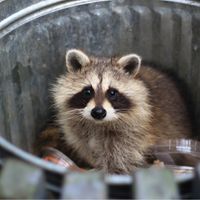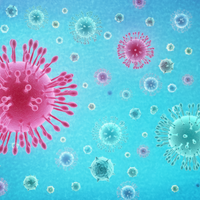zoonoses

Opinion: Eating Right to Avoid Catastrophe
Giulia Wegner and Kris A. Murray | Oct 3, 2022 | 5 min read
The key to averting cataclysmic events, such as pandemics, climate change, and mass extinction of species, lies partly in what’s on our plates.

Opinion: A Dog Has Caught Monkeypox from One of Its Owners, Highlighting Risk of the Virus Infecting Pets and Wild Animals
Amy Macneill, The Conversation | Aug 19, 2022 | 5 min read
The monkeypox virus can easily spread between humans and animals. A veterinary virologist explains how the virus could go from people to wild animals in the US—and why that could be a problem.

Monkeypox Likely Spread Undetected in US Before Recent Reports
Andy Carstens | Jun 6, 2022 | 2 min read
Two strains of monkeypox have been detected in the US, suggesting the virus has been circulating in the country for some time, the CDC says.

US Case Adds to Unusual Monkeypox Outbreak
Natalia Mesa, PhD | May 19, 2022 | 4 min read
Experts are scrambling to understand clusters of the normally rare disease that have been reported in Europe and North America in the last month.

New Preprints Further Implicate Market in Pandemic’s Origins
Natalia Mesa, PhD | Feb 28, 2022 | 4 min read
Three studies that analyzed samples from Wuhan’s Huanan Seafood Wholesale Market add to evidence that SARS-CoV-2 has zoonotic origins.

The Rise of COVID-19 Vaccines for Animals
Chris Baraniuk | Dec 9, 2021 | 6 min read
Thousands of animals have had their shot already. How many more really need it?

Tool Identifies Likely Reservoir Species for SARS-CoV-2
Emma Yasinski | Nov 16, 2021 | 4 min read
Researchers used sequencing data and phenotypic traits to predict which of 5,400 species were most likely to be susceptible to contracting and spreading the virus back to humans.

Texas Monkeypox Case Underscores Need for Better Surveillance
Christie Wilcox, PhD | Jul 30, 2021 | 5 min read
A patient caught the rare disease in Nigeria before flying through two US airports, exposing more than 200 people from 27 states.

Q&A: New Tool Ranks Viruses by Their Risk of Jumping to Humans
Jef Akst | Apr 9, 2021 | 4 min read
Researchers involved in a long-term project to identify viruses of concern have now assessed the risk factors that could help forecast which pathogens are the most likely to spillover from wildlife to people.

Are Climate-Driven Shifts in Bat Diversity to Blame for COVID-19?
Asher Jones | Feb 12, 2021 | 4 min read
A study proposes that habitat for bats—and their accompanying coronaviruses—has increased in southern Asia over the last century, but experts debate the reliability of the analysis.

WHO Discounts Idea that SARS-CoV-2 Leaked from a Lab
Kerry Grens | Feb 9, 2021 | 2 min read
An investigation by the World Health Organization into the origins of COVID-19 will instead focus on the virus’s animal origins and the possibility of spread through frozen foods.

Denmark to Cull 17 Million Mink Amid SARS-CoV-2 Mutation Concerns
Lisa Winter | Nov 5, 2020 | 2 min read
Government authorities say because the animals are good hosts of the novel coronavirus, and this new viral variant could undermine vaccine efforts against COVID-19, they are destroying the nation's entire stock of mink.

Alterations in Immune Genes Make Bats Great Viral Hosts
Abby Olena, PhD | Oct 27, 2020 | 3 min read
Bat species use different strategies to dampen immune activation in response to viruses.

Disrupted Habitats Have More Zoonotic Disease Hosts: Study
Lisa Winter | Aug 6, 2020 | 2 min read
Animals that can host pathogens dangerous to humans, such as rodents, birds, and bats, are proportionately more common in human-occupied spaces than in remote areas.

DNA Could Thwart Trade of the World’s Most Trafficked Mammal
Diana Kwon | Aug 6, 2020 | 4 min read
Pangolins are poached for their scales and meat, leading researchers to develop a set of molecular tools to help track and mitigate the trade.

Tracking Pangolin Traffic Networks
The Scientist | Aug 6, 2020 | 1 min read
Working at bushmeat markets in Africa, researchers are trying to trace the trade networks of the mammals.

Which Species Transmit COVID-19 to Humans? We’re Still Not Sure.
Claire Jarvis | Mar 16, 2020 | 3 min read
Preliminary modeling studies provide a shortlist of potential coronavirus intermediate host species.

Scientists Scrutinize New Coronavirus Genome for Answers
Emma Yasinski | Jan 23, 2020 | 5 min read
Researchers are trying to figure out where it came from, whether it’s evolving, and just how big a threat it will be.

One Dead in Pneumonia Outbreak from New Coronavirus in China
Amy Schleunes | Jan 13, 2020 | 2 min read
Scientists release a draft genome of the virus that has been identified in 41 patients.
